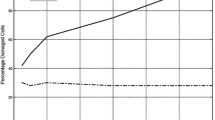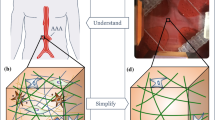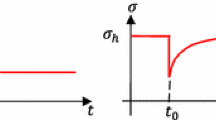Abstract
The aetiology of pressure ulcers is poorly understood. The complexity of the problem, involving mechanical, biochemical, and physiological factors demands the need for simpler model systems that can be used to investigate the relative contribution of these factors, while controlling others. Therefore, an in vitro model system of engineered skeletal muscle tissue constructs was developed. With this model system, the relationship between compressive tissue straining and cell damage initiation was investigated under well-defined environmental conditions. Compression of the engineered muscle tissue constructs revealed that cell death occurs within 1–2 h at clinically relevant straining percentages and that higher strains led to earlier damage initiation. In addition, the uniform distribution of dead cells throughout the constructs suggested that sustained deformation of the cells was the principle cause of cell death. Therefore, it is hypothetised that sustained cell deformation is an additional mechanism that plays a role in the development of pressure ulcers. © 2003 Biomedical Engineering Society.
PAC2003: 8719Rr, 8719Ff, 8718La, 8780Rb
Similar content being viewed by others
References
Bell, E., B. Ivarsson, and C. Merril. Production of a tissue-like structure by contraction of collagen lattices by human fibroblasts of different proliferative potential. Proc. Natl. Acad. Sci. U.S.A. 76:1274–1278, 1979.
Bliss, M. R. Aetiology of pressure sores. Clin. Gerontology 3:379–397, 1993.
Bosboom, E. M. H., C. V. C. Bouten, C. W. J. Oomens, H. W. vanStraaten, F. P. T. Baaijens, and H. Kuipers. Quantification and localisation of damage in rat muscles after controlled loading: A new approach to study the aetiology of pressure sores. Med. Eng. Phys. 23:195–200, 2001.
Bouten, C. V. C., E. M. H. Bosboom, and C. W. J. Oomens. The aetiology of pressure sores: A tissue and cell mechanics approach. In: Biomedical Aspects of Manual Wheelchair Propulsion: The State of the Art II, edited by L. H. V. van de Woude, M. T. E. Hopman, and C. H. van Kemenade. Amsterdam: IOP, 1999, pp. 52–62.
Bouten, C. V. C., R. G. M. Breuls, E. A. G. Peeters, C. W. J. Oomens, and F. P. T. Baaijens. models to study compressive strain-induced muscle cell damage. Biorheology 40:383–388, 2003.
Bouten, C. V. C., M. M. Knight, D. A. Lee, and D. L. Bader. Compressive deformation and damage of muscle cell subpopulations in a model system. Ann. Biomed. Eng. 29:153–163, 2001.
Breuls, R. G. M., A. Mol, R. Petterson, C. W. J. Oomens, F. P. T. Baaijens, and C. V. C. Bouten. Monitoring local cell viability in engineered tissues: A fast, quantitative and nondestructive approach. Tissue Eng. 9:269–281, 2003.
Breuls, R. G. M., B. G. Sengers, C. W. J. Oomens, C. V. C. Bouten, and F. P. T. Baaijens. Predicting local cell deformations in engineered tissue constructs: A multilevel finite element approach. J. Biomech. Eng. 124:198–207, 2002.
Daniel, R. K., D. L. Priest, and D. C. Wheatley. Etiologic factors in pressure sores: An experimental model. Arch. Phys. Med. Rehabil. 62:492–498, 1981.
Dinsdale, S. M. Decubitus ulcers: Role of pressure and friction in causation. 55, 1974.
Dodd, K. T., and D. R. Gross. Three-dimensional tissue deformation in subcutaneous tissues overlying bony prominences may help to explain external load transfer to the interstitium. J. Biomech. 24:11–19, 1991.
Errington, R. J., M. D. Fricker, J. L. Wood, A. C. Hall, and N. S. White. Four-dimensional imaging of living chondrocytes in cartilage using confocal microscopy: A pragmatic approach. Am. J. Physiol. 272:C1040–C1051, 1997.
Guilak, F. Volume and surface area measurement of viable chondrocytes using geometric modelling of serial confocal sections. J. Microsc. 173:245–256, 1994.
Hartley, R. S., and Z. Yablonka-Reuveni. Long term maintenance of primary myogenic cultures on a reconstituted basement membrane. In Vitro Cell Dev. Biol. 26:955–961, 1990.
Husain, T. An experimental study of dome pressure effects on tissues, with reference to the bedsore problem. J. Pathol. Bacteriol. 66:347–358, 1953.
Kokate, J. Y., K. J. Leland, A. M. Held, G. L. Hansen, G. L. Kveen, B. A. Johnson, M. S. Wilke, E. M. Sparrow, and P. A. Iaizzo. Temperature-modulated pressure ulcers: a porcine model. Arch. Phys. Med. Rehabil. 76:666–673, 1995.
Kosiak, M. Etiology of decubitus ulcers. Arch. Phys. Med. Rehabil. 42:19–29, 1961.
Kosnik, P. E., J. A. Faulkner, and R. G. Dennis. Functional development of engineered skeletal muscle from adult and neonatal rats. Tissue Eng. 7:573–584, 2001.
Michel, C. C., and H. Gillot. Microvascular mechanisms in stasis and ischaemia. In: Pressure Sores: Clinical Practice and Scientific Approach, edited by D. L. Bader. London: MacMillan, 1990, pp. 153–163.
Nola, G. T., and L. M. Vistnes. Differential response of skin and muscle in the experimental production of pressure sores. J. Plast. Reconstr. Surg. 66:728–733, 1980.
Powell, C., B. L. Smiley, J. Mills, and H. H. Vandenburgh. Mechanical stimulation improves tissue engineered human skeletal muscle. Am. J. Physiol. 52:C1557, 2002.
Reddy, N. P. Effects of mechanical stresses on lymph and interstitial flows. In: Pressure Sores: Clinical Practice and Scientific Approach, edited by D. L. Bader. London: MacMillan, 1990, pp. 203–220.
Reddy, N. P., and G. V. Cochran. Interstitial fluid flow as a factor in decubitus ulcer formation. J. Biomech. 14:879–881, 1981.
Reswick, J., and J. Rogers. Experience at rancho los amigos hospital with devices and techniques to prevent pressure sores. In: Bed Sore Mechanics, edited by R. M. Kennedy, J. M. Cowden, and J. J. Scales. London: MacMillan, 1976, pp. 301–310.
Salcido, R., J. C. Donofrio, S. B. Fisher, E. K. LeGrand, K. D. Dickey, R. Schosser, and R. Liang. Histopathology of pressure ulcers as a result of sequential computer-controlled pressure sessions in a fuzzy rat model. Lasers Eng. 7:23–40, 1994.
Schoonhoven, L., J. R. E. Haalboom, and M. T. Bousema. Prospective cohort study of routine use of risk assessment scale for prediction of pressure ulcers. Br. Med. J. 325:797–799, 2002.
Shansky, J., M. Del Tatto, J. Chromiak, and H. Vandenburgh. A simplified method for tissue engineering skeletal muscle organoids. In Vitro Cell. Dev. Biol.: Anim. 33:659–661, 1997.
Todd, B. A., and J. G. Thacker. Three-dimensional computer model of the human buttocks,. J. Rehabil. Res. Dev. 31:111–119, 1994.
Vandenburgh, H. H. A computerized mechanical cell stimulator for tissue culture: effects on skeletal muscle organogenesis. In Vitro Cell Dev. Biol. 24:609–619, 1988.
Vandenburgh, H. H., M. Del Tatto, J. Shansky, J. Lemaire, A. Chang, F. Payumo, P. Lee, A. Goodyear, and L. Raven. Tissue-engineered skeletal muscle organoids for reversible gene therapy. Hum. Gene Ther. 7:2195–2200, 1996.
Vandenburgh, H. H., P. Karlisch, and L. Farr. Maintenance of highly contractile tissue-cultured avian skeletal myotubes in collagen gel. In Vitro Cell Dev. Biol. 24:166–174, 1988.
White, N. S., R. J. Errington, M. D. Fricker, and J. L. Wood. Aberration control in quantitative imaging of botanical specimens by multidimensional fluorescence microscopy. J. Microsc. 181:99–116, 2001.
Zhang, M., A. R. Turner-Smith, and V. C. Roberts. The reaction of skin and soft tissue to shear forces applied externally to the skin surface. Proc. Inst. Mech. Eng. 208:217–222, 1994.
Author information
Authors and Affiliations
Rights and permissions
About this article
Cite this article
Breuls, R.G.M., Bouten, C.V.C., Oomens, C.W.J. et al. Compression Induced Cell Damage in Engineered Muscle Tissue: An In Vitro Model to Study Pressure Ulcer Aetiology. Annals of Biomedical Engineering 31, 1357–1364 (2003). https://doi.org/10.1114/1.1624602
Issue Date:
DOI: https://doi.org/10.1114/1.1624602




